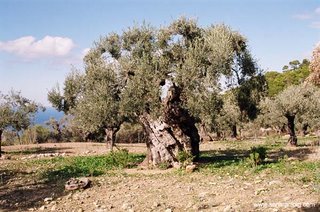PRUNING OLIVE
Some notes on theory and practice of pruning olive
Hypothesis
The main criterion for choosing the technique of pruning and training system of the crown, should be the cost, followed by compliance physiological needs of the plant and the choice of management olive.
Before working with the pruning is important observe the plant in order to perform an intervention and subjective for each tree.
What is pruning
Pruning includes a series of manipulations to help the structure of hair, influence the development of vegetative and reproductive organs and modulate the growth of the outdoor and roots, to optimize the amount 'and AS' of the harvest to maximize the profitability of the crop. Pruning is the second largest expenditure after harvest (80-85%) and the costs vary from 6% to 30% of the total costs of farming. Background information for the olive pruning The pruning technique used for the olive tree is different from that used for other fruit trees, because of the peculiar characteristics of vegetative reproduction of this species.
- high vegetative activity - The olive tree is able to recover quickly pruning errors or damage to the vegetation, pushing even after drastic cuts.
- Gems and branches - The olive tree has branches mostly mixed, simpler than other fruit trees (there are no arrows, brindelli etc. ..).
- Lifecycle - The plant is very long-lived (only one of the crops), but now we tend to steer business decisions on 30 years of production.
- Habitus growth - bushy, the crown of the plant tends to assume a globular shape in time.
- evergreen species - the olive leaves are persistent and normally live for two or three years.
- alternate bearing - Alternating production is caused by many biological factors and internal but also external factors (eg late frost) can influence this phenomenon. The alternation may occur in different ways even on branches belonging to the same plant.
To counter this and to balance the plant should act more strongly in the year of charge, thereby reducing the production and the plant in the year of discharge. The positive action of these activities is linked to the inhibitory activity on the induction carrying the fruits to flower the following year, and restore the balance of vegetative and reproductive plant.
- Water consumption - The olive tree has limited water consumption and mechanisms of tolerance to water deficit. By pruning and can reduce the evapotranspiration of the plant during periods of intense drought stress (a practice used in some of the driest regions of Spain).
Objectives of pruning
1. Form and maintain the structure of the plant;
2. enable a rapid entry into production;
3. a large scale production;
4. maximize light interception by the canopy;
5. remove the branches and fruit to prevent aging Crown;
6. achieve and maintain vegetative - reproductive;
7. control the size of the plant (branch cuts);
8. eliminate the dead wood (not so widespread);
9. retrieve the crown after a stress;
10. rejuvenate old trees or abandoned;
11. adapted to mechanical harvesting old trees;
12. facilitate the control of pests and diseases (secondary oil);
13. improve the quality of the fruit cultivars table;
14. improve the aesthetics of monumental or ornamental plants.
The olive is a kind Basitona , so the branches at the baseline, are more developed than those in the upper part (diamond shape of the crown). The relationship between the height and width of the plant varies during the time going from long to wide width. The bending of the branches is a strategy not recommended in Olive (used in the past for the formation of the vessel polyconic), due to the formation of suckers.
When you enter a secondary branch on the main one with an angle greater than 60 ° should act eliminating it before it can provide shade and take effect at the main branch (shoots). When we fail to act preventively we can remove the main branch and let the sprouts develop.
This procedure leads to the formation of a "duck neck" structure is not suitable for mechanical harvesting. More to the suckers, cause a reduction in the main branch also the bottlenecks that occur when three branches grow on the same node. Again it is important to act early exit branches in competition with the central axis.
When this happens it is not obliged to remove the central axis and choose a new tip.
Frutificazione
fruiting olive tree is oil, on the branches of the previous year. When pruning is therefore important to assess both the production requirements of the current year (N) of the next (N +1).
These forecasts notes on the biology of fruit-bearing olive, must be well aware that every time with scissors in hand we come to the plant for an operation as complex and important as pruning.

0 comments:
Post a Comment